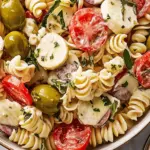This Japanese Pasta Salad is not your ordinary side dish. Drawing on traditional Japanese ingredients like Kewpie mayonnaise, soy sauce, and sesame oil, it’s creamy, savory, and full of umami. The crunch of English cucumber, delicate slices of ham, and the unexpected touch of Shichimi pepper make this a standout dish perfect for gatherings or a flavorful lunch.
Originally inspired by Japanese potato salad, this noodle-based version is just as versatile and comforting. It’s quick to make, easy to customize, and stays fresh and delicious even when prepared in advance. Whether you serve it in a lunch bento box or bring it to a summer cookout, it’s sure to be the first bowl to disappear.
Full Recipe
-
1 lb bow-tie pasta (or any preferred pasta)
-
2 hard-boiled eggs, peeled and chopped
-
4–5 slices of ham, sliced into strips
-
1 1/2 cups English cucumber, seeded and cut into matchsticks
-
1/2 medium white onion, thinly sliced
-
3 green onions, finely chopped
-
Optional: paprika, cayenne, or Shichimi pepper for garnish
Dressing:
-
1 cup Japanese mayonnaise (Kewpie recommended, or a blend of Japanese and regular)
-
1 tbsp low-sodium soy sauce
-
1 tbsp rice vinegar
-
2 tsp sesame oil
Directions:
-
Cook pasta according to package directions until al dente. Rinse under cold water and drain.
-
Salt the sliced white onions generously and massage. Let sit for 10 minutes, then rinse and squeeze out excess moisture.
-
Slice cucumbers into matchsticks, keeping some skin for color. Cut ham into thin strips.
-
In a large bowl, whisk together the mayonnaise, soy sauce, sesame oil, and rice vinegar.
-
Add cooked pasta, cucumbers, ham, white onions, and half the green onions to the dressing. Toss to coat evenly.
-
Top with chopped hard-boiled eggs and remaining green onions.
-
Cover and refrigerate for at least 1 hour. Garnish with Shichimi or paprika before serving, if desired.
Prep Time: 15 minutes | Cooking Time: 10 minutes | Total Time: 25 minutes
Kcal: ~350 kcal per serving | Servings: 8 servings
Introduction to Japanese Pasta Salad
Japanese cuisine is known for its delicate balance of flavors, attention to detail, and artful presentation. While many people are familiar with sushi, ramen, and tempura, there are lesser-known dishes that bring the comfort and creativity of Japanese home cooking to light. One such example is Japanese Pasta Salad—a dish that blends the refreshing elements of a Western-style pasta salad with uniquely Japanese ingredients like Kewpie mayonnaise, rice vinegar, and Shichimi pepper.
This colorful and creamy salad is a staple at gatherings, especially during the warmer months, offering a cool, satisfying alternative to heavier side dishes. What makes this salad particularly special is how it reflects the Japanese approach to food: simple, balanced, and versatile, yet full of nuanced flavor.
The Evolution of Pasta Salad in Japanese Cuisine
Though pasta is not native to Japan, it has been enthusiastically adopted into modern Japanese cooking. Spaghetti and macaroni became widely available in Japan after World War II, and Japanese cooks quickly began putting their own spin on Western-style pasta dishes. This adaptation gave birth to the concept of wafuu (Japanese-style) pasta, which includes ingredients such as soy sauce, seaweed, and mentaiko.
The Japanese Pasta Salad evolved as a fusion of Western cold pasta salad and Japanese potato salad, the latter of which is a much-loved side dish in bento boxes and family meals. As with Japanese potato salad, this dish focuses on creamy textures, crunchy vegetables, and the unmistakable taste of Japanese mayonnaise.
What Sets Japanese Pasta Salad Apart
The defining feature of this salad is Japanese mayonnaise, most famously Kewpie. Unlike American mayonnaise, Kewpie uses only egg yolks rather than whole eggs, giving it a richer, more custard-like texture. It’s also made with rice vinegar instead of distilled vinegar, which adds a subtle sweetness and a mild acidity. Additionally, Kewpie is seasoned with a dash of MSG and sometimes mustard or dashi, lending an umami-packed flavor that’s hard to replicate with regular mayo.
Combined with traditional salad components like ham, cucumbers, and onions, Japanese mayo transforms this dish from a basic pasta salad into something truly crave-worthy. A few spoonfuls of soy sauce, sesame oil, and rice vinegar further elevate the dressing, adding depth and balance.
Customization and Flexibility
One of the most appealing aspects of Japanese Pasta Salad is how easy it is to customize. While bow-tie pasta is often used for its visual appeal, spaghetti or macaroni can also be excellent options. In Japan, spaghetti is commonly used and is often broken in half before cooking for ease of mixing and eating. Whichever pasta you choose, make sure it’s cooked al dente to prevent the salad from turning mushy once dressed.
The vegetables are equally flexible. English cucumber is preferred for its low water content and crispness, but you can use Persian cucumbers, carrots, or even sweet corn to change things up. Ham is a classic protein in this salad, though it can be replaced with shredded chicken, canned tuna, or imitation crab sticks (kanikama) for a seafood twist.
To add heat or additional flavor complexity, a sprinkle of Shichimi Togarashi (Japanese seven-spice blend), cayenne, or paprika is often recommended just before serving.
Cultural Context and Serving Ideas
In Japanese homes, salads like this one are commonly served as a side dish rather than a main course. They’re often placed in small bowls alongside rice, pickles, and grilled fish or meat. In the U.S. or other Western settings, however, this pasta salad can easily become a star of the table at potlucks, barbecues, or even holiday feasts. It travels well, holds its texture after refrigeration, and pairs beautifully with both Japanese and non-Japanese dishes.
It’s also an ideal addition to a bento lunchbox, as its creamy consistency holds up over time and tastes great chilled. With its bright color palette—greens from cucumber and scallions, pinks from ham, yellows from egg, and occasional red flecks from spices—it offers a visually appealing pop in any meal spread.
Why It’s Perfect for Modern Lifestyles
Modern cooks are often looking for dishes that are both nutritious and easy to prepare. This pasta salad checks both boxes. With minimal cooking involved (just boiling pasta and eggs), the rest of the recipe involves slicing, mixing, and chilling. The flavors intensify after an hour in the fridge, so it’s perfect for make-ahead meal prep.
Additionally, the blend of carbs, protein, and vegetables makes it well-balanced and satisfying. The richness of the mayonnaise-based dressing also means that a small portion is enough to feel indulgent without being overly heavy. And thanks to its versatility, you can make small tweaks based on dietary needs—substitute vegan mayo, use gluten-free pasta, or load it with extra veggies for a plant-based version.
Tips for Making the Best Japanese Pasta Salad
-
Don’t skip the onion massage. Rubbing the onions with salt helps break down their sharpness and softens their texture, making them more pleasant in a cold dish.
-
Chill before serving. Letting the salad sit for at least an hour allows the flavors to meld and the dressing to penetrate the ingredients.
-
Balance the mayo. If you’re unsure about using all Japanese mayonnaise, try blending it half-and-half with regular mayo until you find your preferred balance of richness and tang.
-
Go bold with toppings. A little sprinkle of Shichimi Togarashi adds not only spice but also color and a delightful citrusy aroma from the dried orange peel in the spice blend.
-
Use quality ingredients. Since this dish is so simple, every ingredient stands out. Use fresh cucumbers, good-quality ham, and authentic Japanese mayo if you can find it.
Health Considerations
While this salad contains mayonnaise, which is often viewed as indulgent, it can be part of a healthy meal when consumed in moderation. You’re getting protein from the eggs and ham, vitamins and fiber from the vegetables, and healthy fats from the sesame oil. To reduce the calorie count, you can lessen the mayo or replace part of it with Greek yogurt or low-fat alternatives.
For those watching their sodium intake, be mindful of the soy sauce and processed meats. Using low-sodium soy sauce and fresh-cooked proteins can help tailor this dish to dietary preferences.
Conclusion
Japanese Pasta Salad is a delightful fusion of East and West—a dish that brings together the creamy comfort of pasta salad with the nuanced, umami-rich flavors of Japanese cuisine. Its versatility, vibrant presentation, and make-ahead convenience make it a winning recipe for any occasion, from casual picnics to elegant dinner spreads.
Whether you’re new to Japanese cooking or a seasoned fan, this dish offers a delicious and accessible way to incorporate authentic Japanese flavors into everyday meals. With its simple preparation and satisfying taste, it’s sure to become a regular favorite in your recipe rotation.
So next time you’re planning a side dish or potluck contribution, skip the ordinary and reach for this Japanese classic reimagined—an easy, flavorful creation that’s as beautiful as it is delicious.






